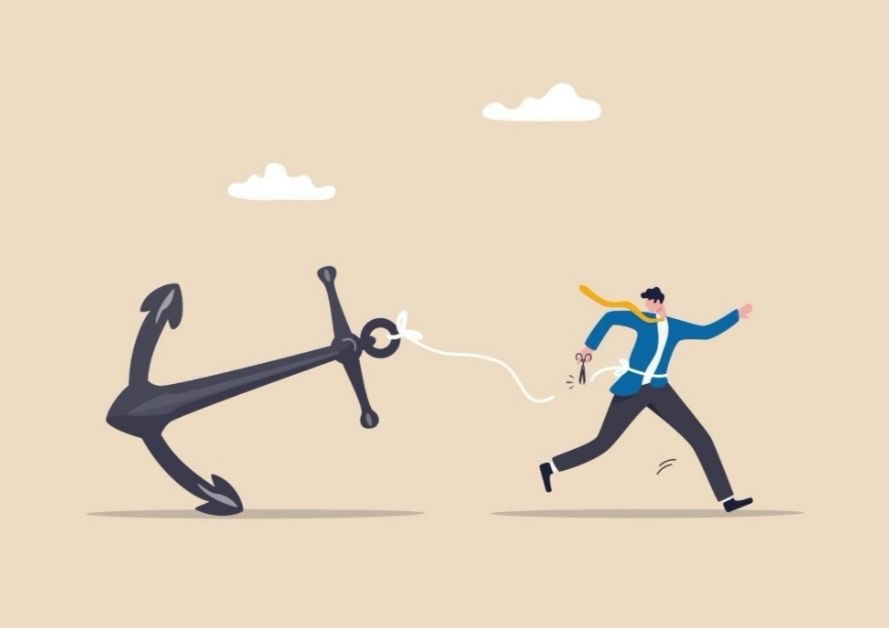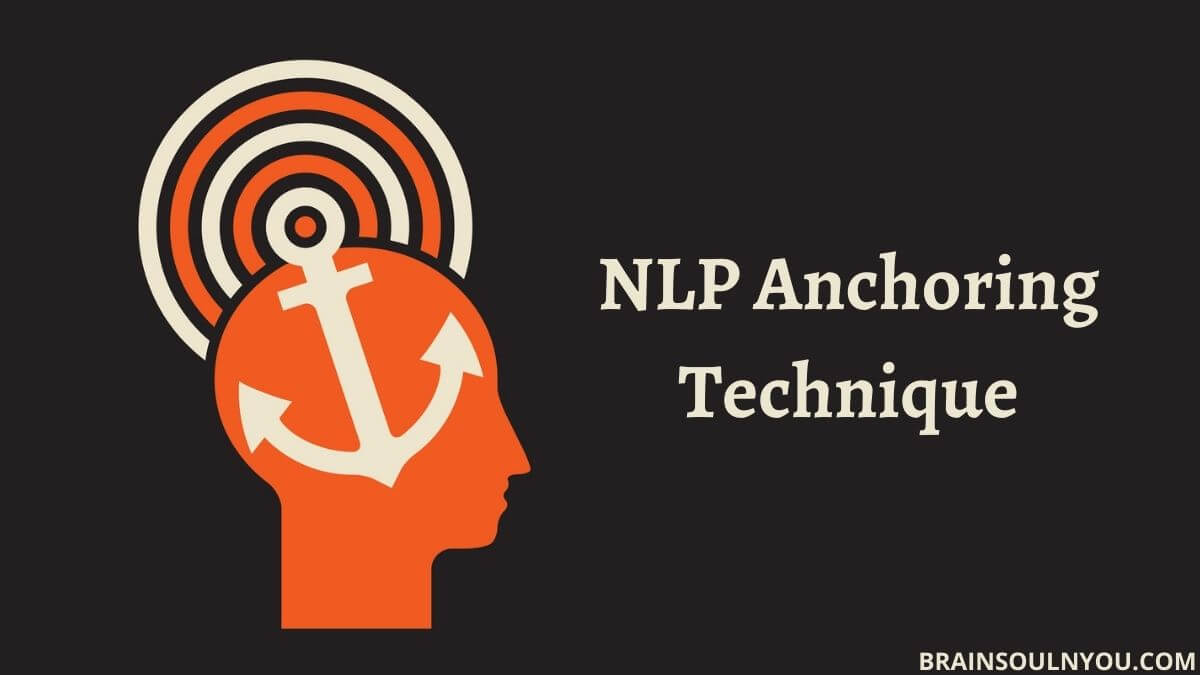NLP anchoring technique changes your negative state of mind into a positive state of mind in a moment. Our body has over 80 billion neurons. These neurons carry many anchors. You can say our inner world is full of anchors. Basically, Anchors are the point by which you go into past memories or a particular event that happened to you. For example, you had a fight with anyone in past. Whenever you see that person your mind shows those fighting with him and your state of mind suddenly changes into anger.
What is Anchor?
Basically, an anchor is something that is used to fix something firmly so that it cannot move. Same in case of us be fix something virtually so that we cannot move. It can be any event, image, sound, emotion, fragrance, taste, etc. For example, you don’t like someone’s face. Whenever you see her/his face you get angry or your mood swing to negative. That means her/his image becomes an anchor of anger in your mind. There are so many anchors in our minds of which we are not aware. In psychology, an anchor term is also known as a trigger. Because when you trigger your point your state of mind change automatically.

This is not necessary anchor will be negative. It can be positive also. But you need to understand which is the positive anchor or which is the negative anchor.
Positive Anchors
Positive anchors are those by which you feel good, motivated, and positive. Some examples of positive anchors are; when you see a flag of your country, you start feeling proud and motivated. A flag is just a piece of cloth with a colorful, decorative pattern. But your emotions are associated with that flag and you are triggered by that.
Have you ever observed when you listen to a song or music with which your sweet memories are attached? As you listen to it goes into that sweet memories. Like that you have sweet memories associated with a fragrance, a picture, sound, or environment. As you smell a fragrance or watch a picture, listen to a sound, and feel an environment you go into that sweet memories.
Negative Anchors
Negative anchors are those by which you feel bad, demotivate, angry, unpleasant, and optimistic. Some examples of Negative anchors are; when someone meets an accident and during that time he or she anchored with a sound or the place. When that person will listen to that sound or will visit that place again, he will start to panic.
People have lots of negative anchors and they are not aware of them. Like, such as a craving for a cigarette just by looking at it, feeling anxiety by looking at someone’s face, or image, or listening to any sound. Some negative anchors are associated with time. As you look at the clock and there is the time when you eat, even if you are not hungry still you start feeling hungry just by looking at the time.
Types of NLP Anchoring
As I mentioned above anchors are set in all sensory systems – visual, auditory, kinesthetic(Feelings or bodily sensations), smell, and taste. An old song may bring back the experience of any event in past. Maybe, the scent of perfume can bring back memories of any festival. So, there are 5 types of NLP anchoring.
Visual NLP Anchoring
It is the most common form of anchoring as most people rely heavily on visual sensory data. We create visual anchors every day. Think about a person you really like, see their face on your mental screen and notice how you feel about that person. Your emotional state is anchored to that person.
Now think of someone who really rubs you the wrong way. See his face on your mental screen and notice how you feel. Positive and negative are anchors because your emotional brain “tags” emotions with experiences just before storing them in long-term memory.
Auditory NLP Anchoring
It is in the form of a sound or inner voice, like an old song, definite self-talk, or a raging tone. These sounds work in the same way that a scene or any other anchor works. These anchors can be negative or even positive depending on what is being anchored.
If students in the classroom hear loud explosions outside the window, many of them run out of their seats to run toward the window. Our mind must have an explanation (visual image) for anything that doesn’t seem safe so that it can be tagged and compared to other similar sounds.
Kinesthetic NLP Anchoring
It is a movement, tactile or physical action that links a particular state of mind. Think about being touched by someone you really like. Notice the intensity of the emotion when they touch you. This is because they are attached to that emotional state.
Now think about being touched by someone you really don’t want to be touched. Again anchors can be positive or negative “coded by the brain” so that’s the difference between “like” and “don’t like” Can you tell? You can develop kinesthetic anchors on your own. It will make you feel more confident, energized, and ready to succeed.
Olfactory NLP Anchoring
The sense of smell is the only sensory channel that is wired directly into the amygdala – the part of the brain that is responsible for “tagging” the anchor with emotional states. It is believed that this is due to sexual intercourse or the reproductive instinct. The smell can be a very powerful anchor. Aromatherapy is very helpful in setting up an anchor for the states you want to experience.
Again, the odor can also be a very negative anchor, for example, sour milk or spoiled eggs. The sense of smell is important for survival because it tells you whether to drink that water or not.
Gustatory NLP Anchoring
Taste tells you whether to chew and swallow versus spitting. It is also important for survival. If there are certain foods that you really don’t like, chances are you get into a very negative emotional state when you think about putting them in your mouth.
What is NLP Anchoring Technique?
NLP Anchoring Technique is a very powerful NLP technique. It helps you to create positive anchors which you can use for your better. By using NLP Anchoring Technique you can collapse your negative anchors as well.
How to Create an NLP Anchor
If you know how to set NLP anchors in a person, anchors can be used purposefully as a powerful tool to manage our emotional state positively. With the practice and knowledge of anchors, we can change our state rather than allow it to change. To understand how to use the NLP anchoring technique I share an experiment that is done by Russian Scientist Ivan Pavlov on dogs. That is known as Pavlov’s Dog Experiment.
Pavlov’s Dog Experiment
In the early 1900s a Russian scientist, Ivan Pavlov, did some research with dogs where he was able to get them to associate eating with the ringing of a bell. Generally, dogs salivate by looking at food. When Pavlov showed food to the dogs by ringing a bell, the dogs started salivating.
In a few days, after ringing the bell just before feeding them several times the dogs started to salivate just at the sound of the bell alone. Pavlov’s experiment was called Classical Conditioning or Stimulus-Response. This is the best experiment to understand the NLP anchoring technique.

How to Set NLP Anchors in a Person
Most of the anchors in your body are created automatically and you anchor regularly. All anchoring is created by the association of thoughts, ideas, feelings, time, or states with a specific event. Yet not all anchors are positive associations. Some anchors are unpleasant or worse.
The Keys to Using and Installing Anchors in Your Life
- Intensity: The intensity of the experience can control how fast the anchor builds engagement. If the experience is extremely intense, the association may only be stronger after one event. On the other hand, if the experience is less intense, it may take several times to connect the state to the experience.
- Timing: The most effective time for anchor engagement is at the peak of the experience. As the intensity of the experience decreases, so does the association. If you can maintain this intensity for a longer period, there is a higher chance that the anchor will be established.
- Uniqueness: It’s best to find an anchor that is unique to the experience. Individuals can use any three types of anchors independently or all together. The key here is to ensure that the anchors are used together and at the same time. Make sure the anchor is only tied to that specific experience, and not general to other experiences.
- Repetition: Practice makes perfect! Like anything, repeating the experience will anchor it permanently. If you are attempting to make an anchor, you may need to repeat this once or twice to be exact. If it’s a sight or a touch, it has to be precise to make it into your mind.
How to use NLP Anchoring Technique
NLP Anchoring Technique is used for creating new positive anchors and collapsing old negative anchors. When you anchor something effectively enough, it will be there whenever you want it.
Create Positive Anchors
NLP Anchoring Technique is used to create positive anchors. If you feel nervous and anxious in any situation, create an anchor so that when you trigger it you will come into a state of confidence and motivation.
Process
First, change your psychology; straighten your spine, broaden your shoulders, and make your breathing normal. Now, imagine the situation in which you are fully confident and experience a state of motivation. Fully associate with the experience before you set the anchor. When your state of confidence and motivation is at its peak, now is the time to create the anchor.

For anchor, you can use any point to trigger it. Like, hitting a punch on your palm. When you are fully associated with the experience then hit the trigger. Feel it again and hit the trigger again. How much you will practice it your anchor will be created more effectively. After creating that anchor you can use it in a tense situation.
Collapse Anchors NLP
This NLP Anchoring Technique is basically to delete the negative anchors by collapsing them with another anchor. In which you imagine the worse situation of a negative anchor and then trigger any point in your body. After that, you imagine another positive situation and create another point to trigger. After creating these anchors you collapse them so that the negative anchor is deleted.
NLP Anchoring in 5 Quick Steps
1. Decide how you want to feel.
For example, “more confident”.
2. Remember a time when you felt really confident?
It can be any memory of when you were feeling confident in any situation. you have a! Relax and let a memory come to mind in which you feel naturally satisfied.
3. Choose an Anchor device that includes touch.
For example, touching your thumb and forefinger together or making a fist.
4. Remember what you saw, heard, and felt in your confident memory.
You must put yourself inside the memory as if living it again. Do not look at the memory from afar; The feelings will not return. You’ll have to be there again.
Keep the memory alive until you start to feel the same amount of confidence coming over you as you felt at the time. As you feel confident coming in, activate your anchoring device from step 3.
For example, touch your thumb and forefinger together when you feel a sense of confidence. When the feeling starts to subside, release your thumb and forefinger. If you’ve done it well and there’s no underlying reason why you shouldn’t feel overconfident, it’s anchor set!
5. Test the anchor.
For example, by touching your thumb and index finger together again in the exact same way, find out if you naturally reach that confident state. Of course, don’t be suspicious and resist the anchor. Let it happen.
Point to Remember
Not all NLP strategies work constantly and with everybody. NLP mooring won’t work in certain conditions. Your certainty anchor might bomb you in a circumstance in which the serious trepidation or dread is more grounded than the anchor you set. Does this imply that NLP mooring is false? No.
It basically implies that mooring may not be a fix for your most dire outcome imaginable. Part of utilizing a decent device like NLP securing is to figure out its impediments. Take your typical nursery digger. It brings about the ideal result in delicate soil with shallow-established weeds.
Since there are many weeds of this sort and delicate soil is normal, garden cultivators are extremely famous. Notwithstanding, attempting to utilize a typical nursery cultivator in rough soil with long, well-established weeds is silly.
NLP securing is the same. It will work under the right circumstances. In different conditions, you might have to add extra gear or perform different undertakings to ‘relax the dirt’.
For any help, you can contact Brain Soul & You.
Saurabh Goel
Saurabh Goel is the Founder and CEO of the Training and Counselling Company Brain Soul & You’. He is an NLP Wellness Coach, Life Coach, Brain analyst, and Trainer for Education, Corporate, and Entrepreneurship. For more than 5 years, he delivered presentations on entrepreneurship, mind programming, and motivation. He did his B.tech in IT and later choose to be a successful psychologist.


